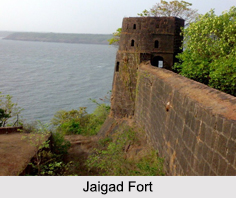 Jaigad Fort is a coastal fortification that is located at the tip of a peninsula in Ratnagiri District of Maharashtra. This fort is also known as the "Fort of Victory". Jaigad Fort is considered as one of the chief ports on the Western Coast of India. It is also said that the mighty fort was built along with another fort named the Vijaygad Fort in order to protect the creek; with the Vijaygad Fort to the North and the Jaigad Fort to the South of the creek. Presently, the fort comes under the Archaeological Survey of India.
Jaigad Fort is a coastal fortification that is located at the tip of a peninsula in Ratnagiri District of Maharashtra. This fort is also known as the "Fort of Victory". Jaigad Fort is considered as one of the chief ports on the Western Coast of India. It is also said that the mighty fort was built along with another fort named the Vijaygad Fort in order to protect the creek; with the Vijaygad Fort to the North and the Jaigad Fort to the South of the creek. Presently, the fort comes under the Archaeological Survey of India.
Location of Jaigad Fort
Nestled on a cliff, the remains of the fort stand steady on a cliff overlooking the Jaigad creek where River Shastri enters the vast and mesmerising Arabian Sea. The fort has a commanding view of the bay, the nearby power plant and the open sea. The fort is located near Jaigad village and is approximately 20 kms to the north-west of Ganpatipule.
History of Jaigad Fort
Jaigad Fort is said to have been built by Bijapur Kings in the 16th century. Later it passed into the hands of Naiks of Sangameshwar. For many years, the Naiks protected it from Bijapur Sultanate and Portuguese. Subsequently, it came under the dominion of Shivaji and his descendant Kingdom of Shahu. In 1713, Jaigad Fort was one of the 10 forts which was ceded by Balaji Vishwanath Peshwa to Angre. In June 1818, this fort was captured by British without any struggle. The fort, although small has a huge significance in the history of Marathas.
Structure of Jaigad Fort
Although in ruins, most of the fort"s outer wall and ramparts still stand. Built with thick walls of red sandstone, this grand structure is an architectural wonder. A deep moat surrounds the fort side not facing the cliff edge. It spreads over an area of 13 acres. The main entrance is in the middle of two bastions. There is a temple inside of the fort premises which is dedicated to Lord Ganesh. There are wells to store water. The palace of Kanhoji Angre is also there. It also possesses a lighthouse, well-tended garden and a museum inside its structure.
Visiting Information of Jaigad Fort
Jaigad Fort is 20 kilometers from Ganpatipule. To reach the fort, one can take a taxi or auto rickshaw from anywhere in the city.



















